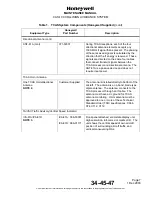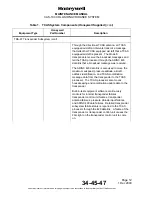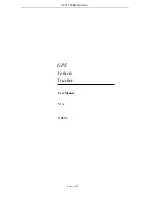
Page 1
1 Dec 2003
34-45-4
7
MAINTENANCE MANUAL
CAS-100 COLLISION AVOIDANCE SYSTEM
Use or disclosure of information on this page is subject to the restrictions in the proprietary notice of this document.
DESCRIPTION AND OPERATION
1. General
This section contains data for the function and the operation of the Honeywell CAS-100 Collision
Avoidance System, hereafter referred as the CAS-100, TCAS, or by its full nomenclature. The
CAS-100 components are shown in Figure
1.
A. Purpose of Equipment
CAS-100 is an airborne traffic alert and collision avoidance advisory system that operates
without the support from Air Traffic Control (ATC) ground stations. The system senses nearby
intruder aircraft equipped with transponders that reply to the Air Traffic Control Radar Beacon
System (ATCRBS), Mode C, or Mode S interrogations. The danger potential of intruder
aircraft to own aircraft is continuously monitored and analyzed by the Traffic Alert and Collision
Avoidance System (TCAS). The nearby transponder-equipped aircraft are shown on a traffic
advisory display. The TCAS system gives traffic advisory alerts and vertical maneuvering
resolution advisories during danger conditions to prevent airborne collisions.
NOTE:
The vertical maneuvering resolution advisories given by TCAS are calculated
and
given against the intruder aircraft that report altitude data in their transponder
messages. Traffic advisories are given for nonaltitude reporting (NAR) aircraft only.
A traffic advisory display warns the flight crew to the position of nearby aircraft threats and
possible threats. This warning improves the ability of the flight crew to see the intruder aircraft
before answering the resolution advisory. The resolution advisories are shown around the
edge of a Traffic Advisory/Vertical Speed Indicator.
A Resolution Advisory/Vertical Speed Indicator displays only resolution advisories around its
edge. The indicator can be used if the traffic advisories are shown on another display unit.
Detection and tracking of intruder aircraft is performed by transmission and receptions from a
top-mounted TCAS directional antenna. This function can also be performed with a
bottom-mounted TCAS omnidirectional or bottom-mounted TCAS directional antenna.
TCAS finds the aircraft that uses a Mode S transponder by listening for the Mode S squitter
transmissions. Mode S transponders tell their presence by transmitting a squitter message
one time for each second. TCAS also finds the aircraft equipped with transponders that do
not reply to Mode S interrogations, but do reply to Mode C interrogations. TCAS must search
for Mode C equipped intruder aircraft, because Mode C transponders do not transmit squitter
messages. When the presence of a Mode S or Mode C intruder is made sure, TCAS starts to
track the intruder. TCAS can track a total of 30 Mode S and Mode C intruders.















































